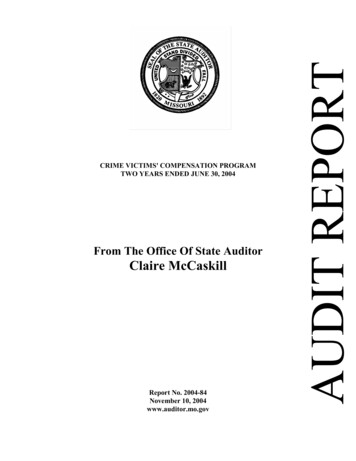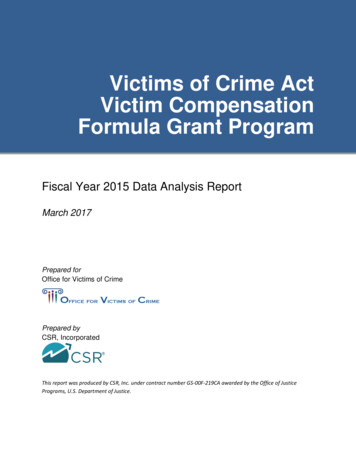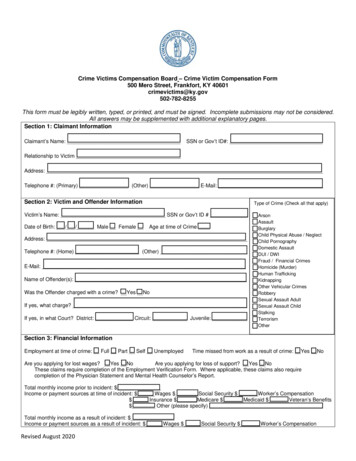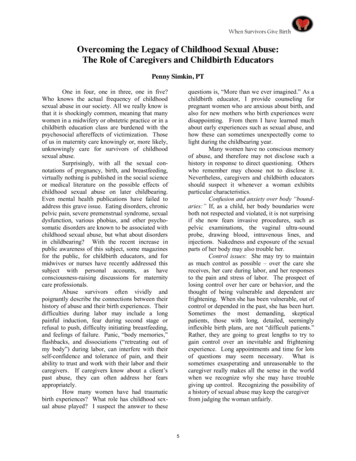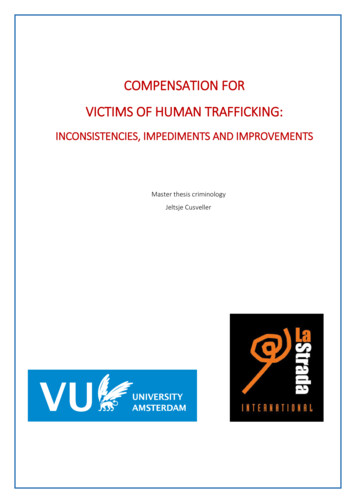
Transcription
COMPENSATION FORVICTIMS OF HUMAN TRAFFICKING:INCONSISTENCIES, IMPEDIMENTS AND IMPROVEMENTSMaster thesis criminologyJeltsje Cusveller
COMPENSATION FOR VICTIMS OF HUMAN TRAFFICKING2Compensation for victims of human trafficking: inconsistencies, impediments andimprovementsMaster thesis criminologyMajor: Organized CrimeFaculty of Law, VU University AmsterdamAuthorJeltsje CusvellerStudent number 2065096jeltsjejoanne@gmail.comReviewersE. Kleemans (reviewer and tutor)M. Wijkman (second reviewer)Internship coordinator and institutionMarieke van DoorninckLa Strada InternationalAugust 2015
COMPENSATION FOR VICTIMS OF HUMAN TRAFFICKINGAcknowledgementsThis thesis was written on behalf of La Strada International. I would like to thank LaStrada, and specifically Marieke van Doorninck, for offering this opportunity and helping meset up the research. From VU University, I would like to thank Edward Kleemans and MiriamWijkman for providing many very helpful comments. I would further like to thank AnnetKoopsen, Eline Willemsen (Fairwork), Conny Rijken (INTERVICT) and Floor Hol (BNRM) fortaking the time to answer my questions, and for giving many useful suggestions. Lastly, Iwould like to thank my father, for all his help and support.3
COMPENSATION FOR VICTIMS OF HUMAN TRAFFICKINGTable of ContentsAbstract. 71 Introduction . 921.1Trafficking in human beings . 91.2Compensation . 101.3Aim of the study. 111.4Method . 111.5Relevance . 121.6Outline . 12International legislation and implementation . 132.1Introduction . 132.2Criminalization and definition of human trafficking . 132.3Victims’ rights. 142.4Right to compensation . 152.5Access to justice and ancillary rights . 162.6Implementation . 172.6.1 Non-identification of victims . 182.6.2 Prejudice . 182.6.3 Lack of legal aid . 182.6.4 Self-identification and fear . 192.6.5 Issues related to compensation via criminal proceedings . 192.6.6 Issues related to compensation via civil court . 222.6.7 Issues related to compensation via a state fund . 232.73Conclusion . 24Dutch legislation: the injured party claim and other routes . 253.1Introduction . 253.2Criminalization of human trafficking . 253.3Ancillary rights and access to justice . 263.4Compensation in criminal law . 263.4.1 Injured party claim . 273.4.2 Compensation measure . 284
COMPENSATION FOR VICTIMS OF HUMAN TRAFFICKING3.4.3 Recent changes in criminal law related to compensation . 2943.5Civil court. 313.6Criminal Injuries Compensation Fund . 313.7Conclusion . 32Compensation in practice: literature review and interviews . 334.1Introduction . 334.2Trafficking Human Beings in the Netherlands . 334.2.1 Victim characteristics . 344.2.2 Profits and damages . 344.3Criminal proceedings: injured party claim. 354.3.1 Method . 354.3.2 Access to court . 364.3.3 Admissibility. 394.3.4 Height of the claim . 404.3.5 Cooperation and expertise . 434.4Criminal proceedings: Compensation measure . 444.5Civil court. 454.6Criminal Injuries Compensation Fund . 464.6.1 Victims . 464.6.2 Obstacles and benefits. 4754.7Experiences with receiving compensation . 474.8Conclusion . 48Case law analysis . 495.1Introduction . 495.2Method . 495.3Number of claims. 515.4Access to court: which human trafficking victims are claiming compensation?545.4.1 Sector of exploitation and sex . 545
COMPENSATION FOR VICTIMS OF HUMAN TRAFFICKING5.4.2 Nationality . 565.4.3 Age . 565.4.4 Obstacles: underrepresented victims . 575.5Admissibility . 585.6Height of the claims: claimed amounts . 595.7Height of the claims: awarded amounts . 615.7.1 Obstacles: height of material damages . 645.7.2 Obstacles: height of immaterial damages . 655.8Fully awarded claims . 665.9Fully inadmissible claims . 675.9.1 Obstacles: foreign and minor victims . 685.9.2 Obstacles: disproportionate burden . 685.10Partially awarded and partially inadmissible cases . 695.11Other notes . 705.11.1Lack of expertise . 705.11.2Fear . 705.11.3Time passed between offence and trial . 715.11.4Compensation measure . 725.1267Conclusion . 72Discussion . 736.1Conclusion . 736.2Issues with the present study and recommendations for future research . 756.3Relevance and recommendations . 776.4Looking forward . 79References . 806
COMPENSATION FOR VICTIMS OF HUMAN TRAFFICKINGAbstractAny person who has been a victim of human trafficking has a right to compensation.Compensation entails the reimbursement of material and immaterial damages a traffickedperson has suffered. Receiving compensation can serve as an acknowledgement ofvictimhood. Restoring money that was taken from a victim both satisfies a sense of injusticeand helps victims on their road to recovery. This can be reached by a verdict that sentencesan offender to pay, or by reimbursement paid by the state itself.Regardless of the internationally acknowledgement right to compensation, thenumber of trafficked persons in Europe that have actually received any reimbursement is verylow. The present study aims to contribute to a rise in the frequency compensation is receivedby trafficked persons by analysing the obstacles to compensation. It has done so byconducting a literature review (covering the years 2010-2012), interviews and a case fileanalysis (covering 2013 and 2014), answering the question which obstacles exist that preventvictims of human trafficking from receiving compensation, both at the European level and thenational level of the Netherlands.Three routes to compensation are currently relevant, each of which has uniqueobstacles related to them; civil court, criminal court and a state fund. At the European level,many impediments are related to legislation or law enforcement. Obstacles related tolegislation include limitations on the amount that can be claimed, the type of damages thatcan be claimed and the victims that can claim compensation. Obstacles related to lawenforcement include a lack identification of victims, a lack of prosecutions and convictionsand prejudice towards victims. Additionally, it was found to be difficult to assess the extent ofthe damage for which a victim should be compensated. Furthermore, lack of information andthe unavailability of free legal aid are obstacles to compensation. Lastly, an important issue atthe international level is that offenders that have been sentenced to pay compensation oftenhave no traceable assets, resulting in non-payment.In the Netherlands, attempts to obtain compensation in criminal court have shown tobe both promising and problematic. Using a provision in criminal law, a victim can append aclaim (‘injured party claim’) for any damages suffered by the trafficking in the offenders’ trial.Another important route is an application to the Criminal Injuries Compensation Fund. It wasfounds that only an estimated four percent of all registered victims claims compensation incriminal court. Additionally, only thirty percent of the victims whose trafficker is being7
COMPENSATION FOR VICTIMS OF HUMAN TRAFFICKINGprosecuted claim compensation in court. A lack of information and unwillingness to claimcompensation on the side of the victim can be causes for this low number of claims. Around aquarter of all these claims in criminal court are fully inadmissible. An important obstaclecausing this is the difficulty with accurately establishing damages. This is related to a lack ofproof in many cases, caused by for example lack of bookkeeping, insufficient financialinvestigation and the incomplete testimonies, which leads to only minimum amounts beingawarded. Availability of proof such a testimonies and bank statements was found to be acharacteristic of awarded cases. However, in some cases where proof seemed sufficientlyavailable, judges still decided to either dismiss the claim, or award a minimum. As a result,compensation is more often than not out of proportion with damages that have actually beensuffered.An improvement in the proportion of claims that was fully inadmissible was observedin 2013 and 2014 compared to the three previous years. New information from the case fileanalysis includes that men and victims of labour exploitation appear underrepresented.Concerning claims on behalf of victims of labour exploitation, these appear in no way to bemore successful than other claims. This further shows that claims are influenced by variousfactors, and that no single factor has a strong individual influence; the success of an injuredparty claim can be influenced by many different factors that can be hard to predict. This ispartly related to the liberty of judges to estimate damages or dismiss claims, abilities that areboth used unpredictably.This study therefore recommends that guidelines be set up for judges, to increase thenumber of claims that are awarded, and the amounts that can be claimed and awarded.Furthermore, victims of trafficking should always be correctly and fully informed of thepossibility to claim compensation. By continuing research and improving different aspects inpractice, it is hoped that more and more victims of human trafficking will receive thecompensation to which they have a legal and moral right.8
COMPENSATION FOR VICTIMS OF HUMAN TRAFFICKING11.1IntroductionTrafficking in human beingsTrafficking in human beings (THB) is a globally relevant issue, affecting nearly everycountry in the world. As a result, there are vast numbers of local, national and regionalinterpretations and responses to this crime (UNODC, 2012). All these responses to this crime,however, have one focus in common: the victims. Human trafficking does not exist withoutthe trafficked persons who become victimized by this crime. The UNODC (2014) registeredover forty thousand victims globally between 2010 and 2012, and Eurostat (2015)registrations record 30,124 victims in the European Union in the same time frame. It is likelythat the actual number of victims is much higher, since a large proportion of this specificcrime remains undiscovered. Although no reliable global estimates exist, the InternationalLabour Organization (ILO) estimates that between 2002 and 2011 twenty million personswere the victim of forced labour, which includes most forms of human trafficking (NationalRapporteur on trafficking in Human Beings, 2013). Human trafficking is further characterizedby the large number of victims who are trafficked in order to work in prostitution. Exploitationof trafficked persons can take place in all work environments imaginable, but according toregistered data, the most prevalent is exploitation in the sex industry. According to Eurostat(2015), 69 percent of all human trafficking is for the purpose of sexual exploitation. Nineteenpercent of trafficking in human beings happens for labour exploitation situations. The victimsof trafficking in human beings are mostly women (67%) and girls (13%). Trafficking of personscan take place within countries, as well as across borders. In Europe, 65 percent of registeredvictims were EU citizens, indicating that trafficking mainly takes place within the region. Anaverage of 37 percent of victims was registered in their home country (Eurostat, 2015).Regardless of sector, country or manner of exploitation, the main goal of humantrafficking is the same: financial profit. Trafficking in human beings is considered to be animportant income source of organized crime groups, grossing an estimated revenue of 114billion euro each year worldwide, and 36 billion euro in Europe (National Rapporteur ontrafficking in Human Beings, 2013; Savona & Riccardi, 2015). A large proportion of theserevenues are earned at the costs of the victims, for example by taking earned money fromthem or by withholding wages. The total damage suffered by trafficked persons is estimated9
COMPENSATION FOR VICTIMS OF HUMAN TRAFFICKINGat thirty billion euro each year in the European Union alone (Levi, Innes, Reuter, & Gundur,2013).1.2CompensationGiven the large severe consequences trafficked persons often suffer due to theirvictimization, it is extremely relevant to implement rights that help them recover effectively.Under international law, the victims of trafficking have a right to be compensated for thedamages they have suffered. This is known as the right to compensation, which can bedefined as “to make amends to someone for loss, injury or wrong, especially by suitablepayment” 1. The right to compensation constitutes the right to reimbursement for bothmaterial (i.e. financial) and immaterial (including for example physical and psychologicalinjuries) damages.Compensation for trafficked persons is necessary for several reasons. Firstly, thedeprived pay for which the victim has worked, and to which he/she has a legal right, isrestored to the victim. Secondly, compensation can be a support on a victims’ road torecovery. It serves as an acknowledgement of victimhood, symbolizes restoration of justiceand provides the much needed financial means to victims to rebuild their lives. The availabilityof financial means also prevents re-victimisation (Geurts & Schrama, 2012; La StradaInternational, 2013; Ruitenbeek-Bart & Schijns, 2014). While the main goal of compensation isto restore justice to the victim, sentencing the trafficker to reimburse the victim is consideredto be a very appropriate punishment, and possibly a deterrent, for a crime which is primarilycommitted for financial profit (La Strada International, 2013).However, recent reports evaluating implementation of the right to compensation,both in European countries and the United States, have shown that human trafficking victims’access to compensation is in many ways limited. Large differences exist between countrieswhen it comes to the safeguarding of the right to compensation. A key finding is that it isextremely rare for victims of human trafficking to receive any compensation at all (La StradaInternational, 2013; Thompson & Jernow, 2008).1Definition of compensation in Chambers 21st Century Dictionary, 2004.10
COMPENSATION FOR VICTIMS OF HUMAN TRAFFICKING1.3Aim of the studyIn order to set out strategies for improvement, the obstacles that keep victims ofhuman trafficking from receiving compensation need to be examined. This will be the goal ofthe present study. In order to understand the obstacles to compensation, it is useful both toreview obstacles at the international level and at national levels. Because every country hasits own legislation concerning human trafficking, studies at the national level are necessary toidentify both country specific problems and national best practices that may be useful forother countries. Reviewing the international level offers a perspective in which the findings atthe national level can be placed. Based on the availability of data, Europe and the Netherlandswere chosen for this analysis.These considerations led to the following main questions:1) Which obstacles prevent victims of human trafficking in Europe from receivingcompensation?2) Which obstacles prevent victims of human trafficking in the Netherlands fromreceiving compensation?1.4MethodIn order to answer the first question, a literature review was carried out. This reviewfocussed on legislation concerning compensation for victims of human trafficking, and reportsinvestigating compensation in practice. For the review of obstacles in the Netherlands, aliterature review and two interviews were carried out. Both national legislation oncompensation and compensation in practice were analysed. From the literature andinterviews, several hypotheses on obstacles to compensation were derived. These weretested in a case file analysis carried out for this study. One specific route to compensation inDutch legislation, the injured party claim, was found to be especially relevant, and thereforereviewed in-depth, both in the literature review, interviews, and case file analysis.Additionally, information of the compensation claim in criminal law is publically available,while details on other routes are not the focus of studies. By using these methods, both thelegal aspect and the practice of claiming compensation can be reviewed. Furthermore, byusing both a case file analysis, a literature review and interviews, the practice of claimingcompensation can be analysed at different stages in the process of claiming compensation,11
COMPENSATION FOR VICTIMS OF HUMAN TRAFFICKINGand from the view of different actors that are involved. It is therefore expected that thesemethods will result in a comprehensive review of obstacles that prevent victims of humantrafficking from receiving compensation. Each chapter’s introduction will further specify themethods used.1.5RelevanceThe aim of the present study is expected to have both societal and scientificimplications. By contributing to a better understanding of obstacles to compensation, it maygive direction to adjustment of political and legal action that can be taken towardsimprovement. In this way, access to appropriate compensation will hopefully be bettered,aiding the well-being of human trafficking victims. In addition to this, the present study mayaid the qualification of damages suffered by the victims of crime. Quantifying damagessuffered by victims is complicated, and not very often a part of studies into crime and/orvictimhood (Levi et al., 2013). Immaterial damages such as the costs of violence (both fromtraffickers and clients), and diminished quality of life are not easy to quantify. This means thatit is not only difficult to appropriately reimburse victims, it also means that available estimatesof damages are very unreliable (Dubourg & Prichard, 2008). This study provides anassessment of the height of damages suffered by trafficked persons based on case studiesinstead of proxies and estimates, and may therefore serve as a step in the direction of a morereliable estimate of damages suffered by the victims of this crime.1.6OutlineThe first two chapters will present the legal framework. First a brief history of the rightto compensation in European law will be given, including a short review of itsimplementation. This included both a review of legal documents and evaluating reports(chapter 2). In chapter 3, the details of the legal right to compensation in Dutch law will beexplained and briefly reviewed. Following, a literature review at the national level of theNetherlands will be presented. This literature review will examine the current knowledge onthe obstacles related to claiming compensation in the Netherland, including previous Dutchjurisprudence research (chapter 4). Chapter 5 provides a detailed explanation of the case fileanalysis, discussing the method and presenting the results from the analysis. Both thesechapters will be supplemented with conclusions drawn from the interviews. The final chapter(6) summarizes and discusses the study, and includes recommendations.12
COMPENSATION FOR VICTIMS OF HUMAN TRAFFICKING22.1International legislation and implementationIntroductionThis chapter tries to answer the first question: Which obstacles prevent victims ofhuman trafficking in Europe from receiving compensation? This is done by a literature review,for which previous reports on compensation were a starting point. The status quo of theimplementation of victims’ rights at the international level is reviewed on a regular basis. Tworecent reports have focussed on reviewing the right to compensation specifically, pointing outnumerous problems. The OSCE Office for Democratic Institutions and Human Rights (ODIHR)has conducted research into several countries’ 2 implementation of the right to compensation(Thompson & Jernow, 2008). The COMP.ACT project, conducted by La Strada Internationaland partners in order to improve access to compensation, included research into theidentification of obstacles that prevent trafficked persons from accessing compensation inthirteen European countries (La Strada International, 2013). 3 These two reports will be thefocus of the last paragraphs of this chapter.The first half of the chapter presents the international legislative documents andguidelines that establish the right to compensation. The review of legislation outlinescriminalization of trafficking in human beings, the rights that trafficked persons have ingeneral, and the right to compensation in specific. The second half of this chapter firstpresents the analysis of the ways in which compensation can be obtained. Secondly, theobstacles associated with each of those ways are analysed, in addition to a review ofobstacles that can arise regardless of the route chosen.2.2Criminalization and definition of human traffickingThe international standard for the definition of trafficking in human beings wasworded in the first globally, legally binding instrument against human trafficking; theTrafficking in Persons Protocol (2001) 4, that was a supplement to the United NationalConvention against Transnational Organized Crime (UNOTC). It is also known as the PalermoProtocol, and defines human trafficking as follows:2US, UK, Ukraine, Russian Federation, Romania, Moldova, France and AlbaniaSee compactproject.org4Fully: The “Protocol to Prevent, Suppress and Punish Trafficking in Persons, Especially Women and Children”, adopted by General Assemblyresolution 55/25. Entered into force on 25 December 2003.313
COMPENSATION FOR VICTIMS OF HUMAN TRAFFICKING“Trafficking in persons shall mean the recruitment, transportation, transfer, harbouringor receipt of persons, by means of the threat or use of force or other forms of coercion, ofabduction, of fraud, of deception, of the abuse of power or of a position of vulnerability or ofthe giving or receiving of payments or benefits to achieve the consent of a person havingcontrol over another person, for the purpose of exploitation. Exploitation shall include, at aminimum, the exploitation of the prostitution of others or other forms of sexual exploitation,forced labour or services, slavery or practices similar to slavery, servitude or the removal oforgans. The consent of a victim of trafficking in persons to the intended exploitation shall beirrelevant” (UN Palermo Protocol, 2000: Art.1).In other words, human trafficking includes at least an act (e.g. recruiting ortransporting a person), means (e.g. use or threat of violence, deception or abuse of power),and purpose (exploitation). Exploitation can take many different forms, but three main formsare distinguished by the Protocol: sexual exploitation, forced labour and removal of organs.Exploitation may also entail working in slave-like conditions, for example in domestic settings(UNODC, 2012). Human smuggling and human trafficking are often confused, but are twodifferent offences. While human smuggling mainly concerns the crossing of a border, humantrafficking also entails exploitation and coercion. Put briefly, being smuggled may bevoluntary, being trafficked never is. A trafficked person may have been smuggled; in thissense smuggling can proceed, or be an element of, human trafficking (Aronowitz, 2001).Subsequent to the Palermo Protocol, several guidelines have been adopted thatfurther specify the measures parties are to take to prevent trafficking, protect potentialvictims and prosecute traffickers 5. Documents concerning these ‘three P’s’, as they aregenerally termed, include articles on how victims should be treated, what rights they have,and how these ri
Another important route is an application to the Criminal Injuries Compensation Fund. It was founds that only an estimated four percent of all registered victims claims compensation in criminal court. Additionally, only thirty percent of the victims whose trafficker is being

